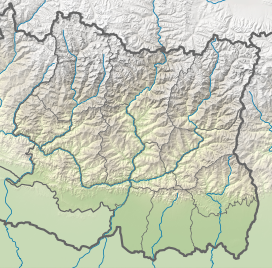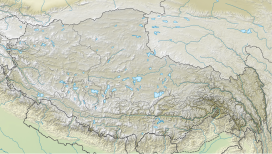| Lhotse | |||
|---|---|---|---|
| Traditional Chinese | 洛子峰 | ||
| Simplified Chinese | 洛子峰 | ||
| |||

Lhotse (Nepali: ल्होत्से, romanized: L'hōtsē [lotse]; Standard Tibetan: ལྷོ་རྩེ, romanized: lho tse, lit. 'South Peak' [l̥otse]; Chinese: 洛子峰) is the fourth-highest mountain on Earth, after Mount Everest, K2, and Kangchenjunga. At an elevation of 8,516 metres (27,940 ft) above sea level, the main summit is on the border between Tibet Autonomous Region of China and the Khumbu region of Nepal.
With Everest to the north and Nuptse to the west, Lhotse forms the apex of the massive horseshoe-shaped arc of the Everest massif. Despite the tremendous vertical relief of its South and Northeast Faces, it is the least prominent of the eight-thousanders due to the great height of the South Col between it and Everest. Lhotse's Western Face, recessed behind the head of the Khumbu Glacier in the Western Cwm, plays an integral part in the standard routes of ascent for both peaks. The name Lhotse, which means "South Peak" in Tibetan, further emphasizes the close relationship between the two.
The main ridge of the mountain features four distinct summits: Lhotse Main at 8,516 m (27,940 ft) AMSL, Lhotse Middle (also called Lhotse Central I or Lhotse East) at 8,414 m (27,605 ft), Lhotse Central II at 8,372 m (27,467 ft), and Lhotse Shar at 8,383 m (27,503 ft). Though Lhotse Main is considered to be an intermediately difficult eight-thousander when ascended from the standard Reiss Couloir route, its secondary summits and extremely steep South Face are regarded as some of the most difficult and dangerous climbs in the world.[4][5] Its icy North East Face remains unclimbed.[6]
Cite error: There are <ref group=nb> tags on this page, but the references will not show without a {{reflist|group=nb}} template (see the help page).
- ^ a b "General Info". 8000ers.com. Retrieved 20 December 2009.
- ^ "Peak Bagger:Himalaya, Central Nepal Himalaya, Khumbu, Ghurka Himal, Annapurna Himal, Xishapangma Area, Sikkim-Eastern Nepal Himalaya, Western Nepal Himalaya, Assam Himalaya, Punjab Himalaya, Bhutan Himalaya, Garwhal Himalaya, Ganesh Himal". Retrieved 22 October 2024.
- ^ Detienne, Herman (1989). "Asia, Nepal, Everest Attempt, Tragedy and Winter Ascent of Lhotse". American Alpine Journal. #31 (63): 203–204. ISBN 9780930410391. ISSN 0065-6925. Retrieved 20 May 2024.
- ^ "Lhotse FAQ: 27,940 feet (8,520 meters)". AlanArnette.com. Retrieved 14 February 2022.
- ^ "Lhotse Shar 8400 meters 2003 expedition". Retrieved 31 March 2024.[dead link]
- ^ "The Expedition Archives of Elizabeth Hawley". Retrieved 31 March 2024.




